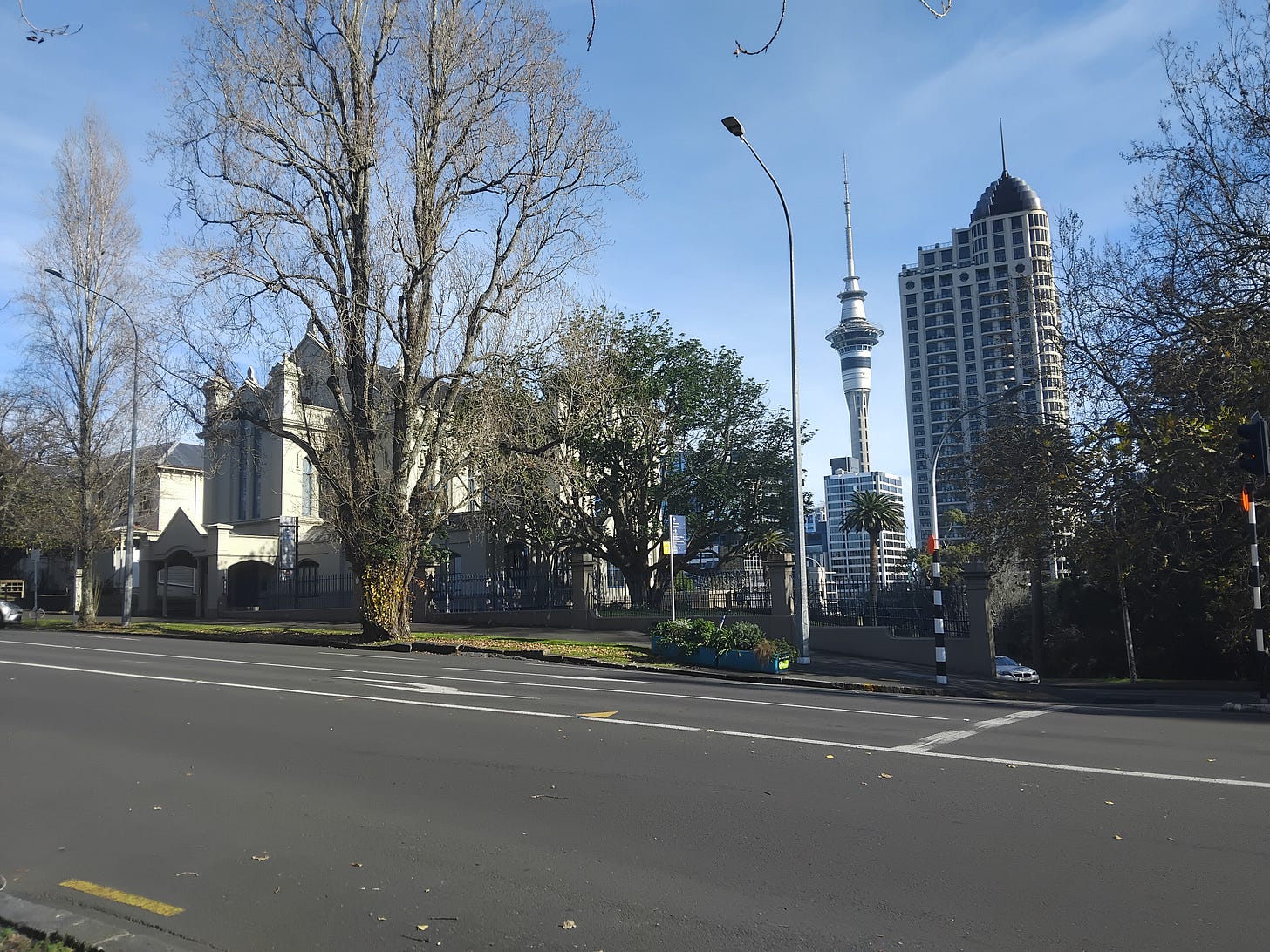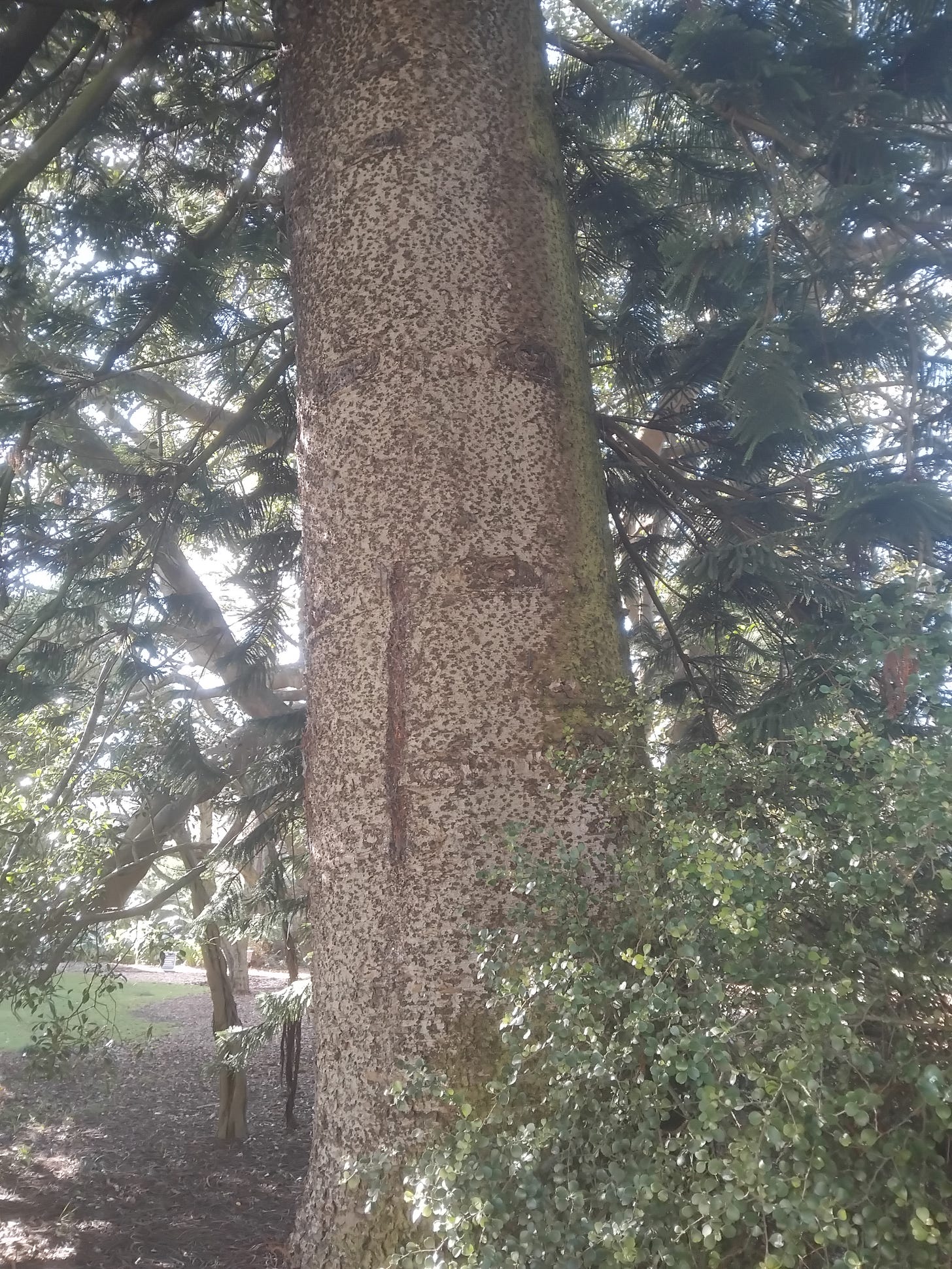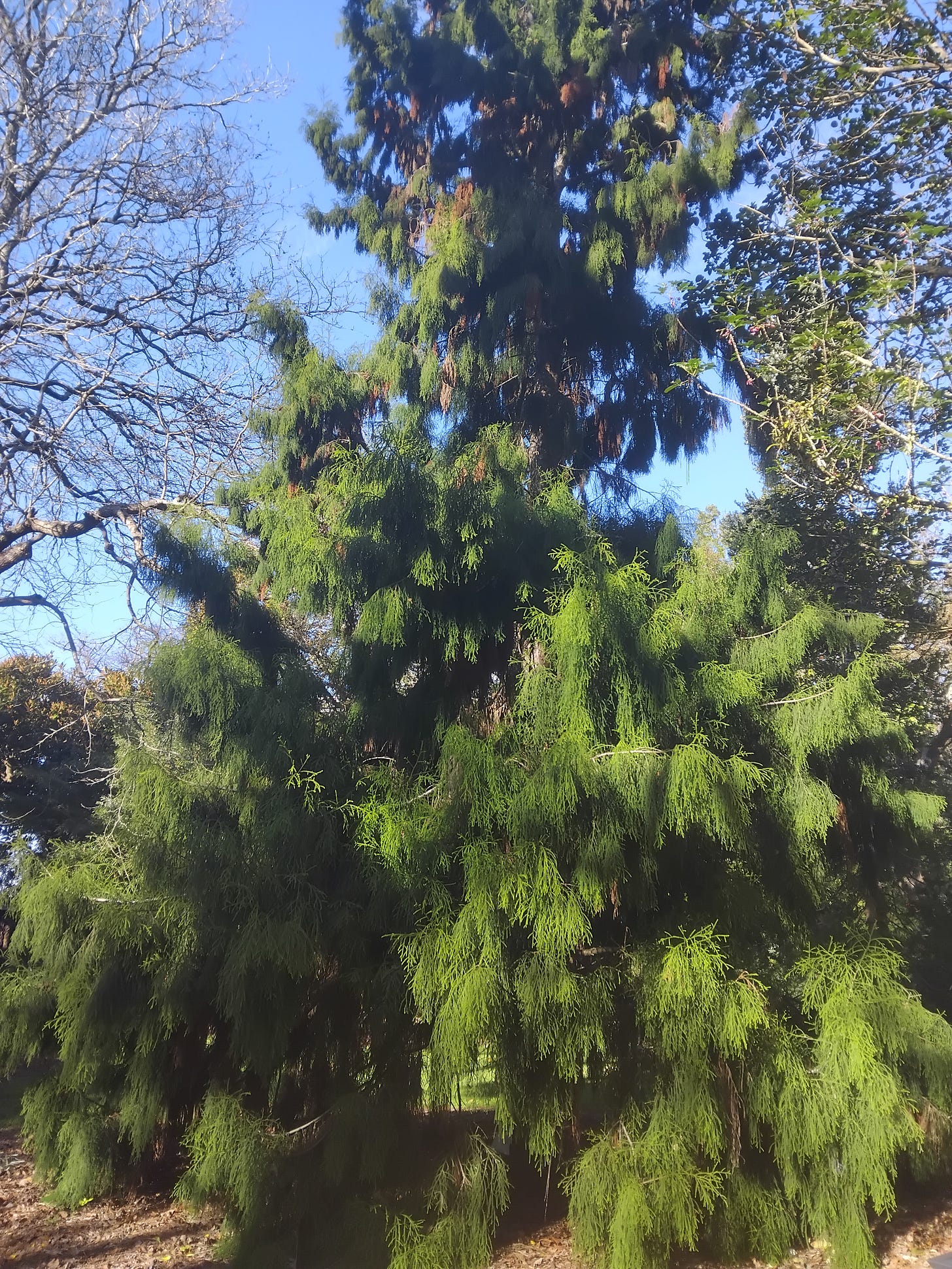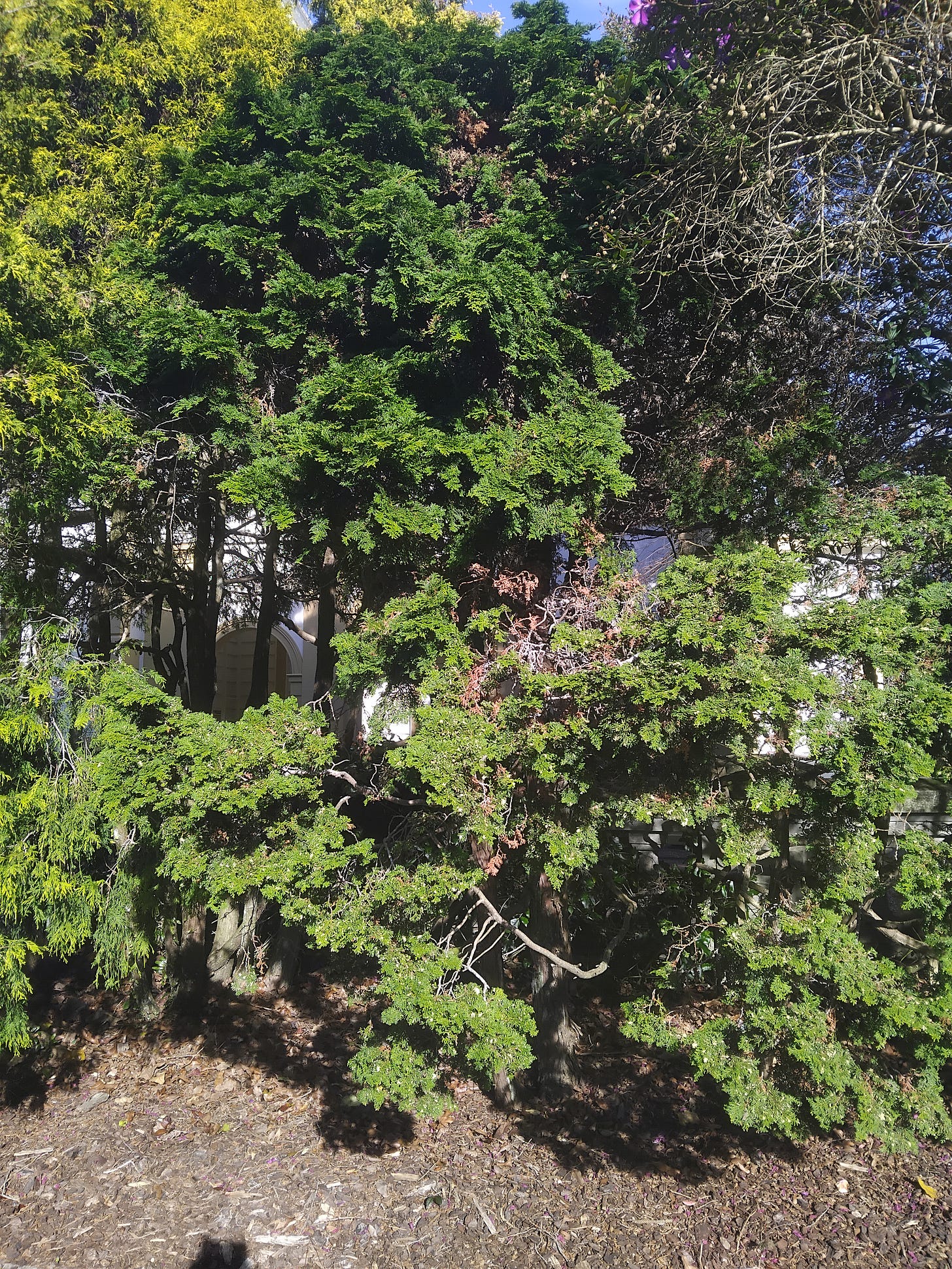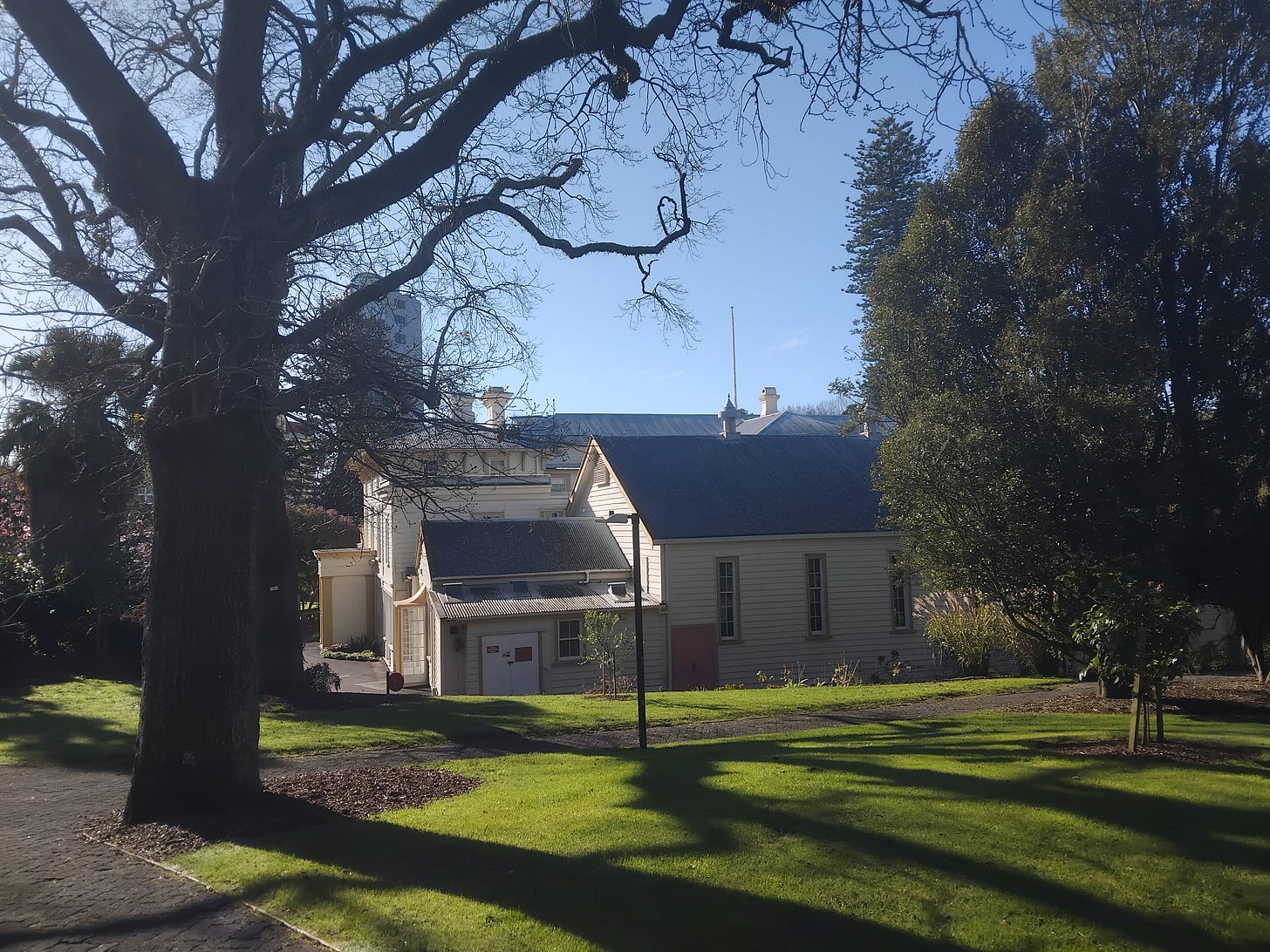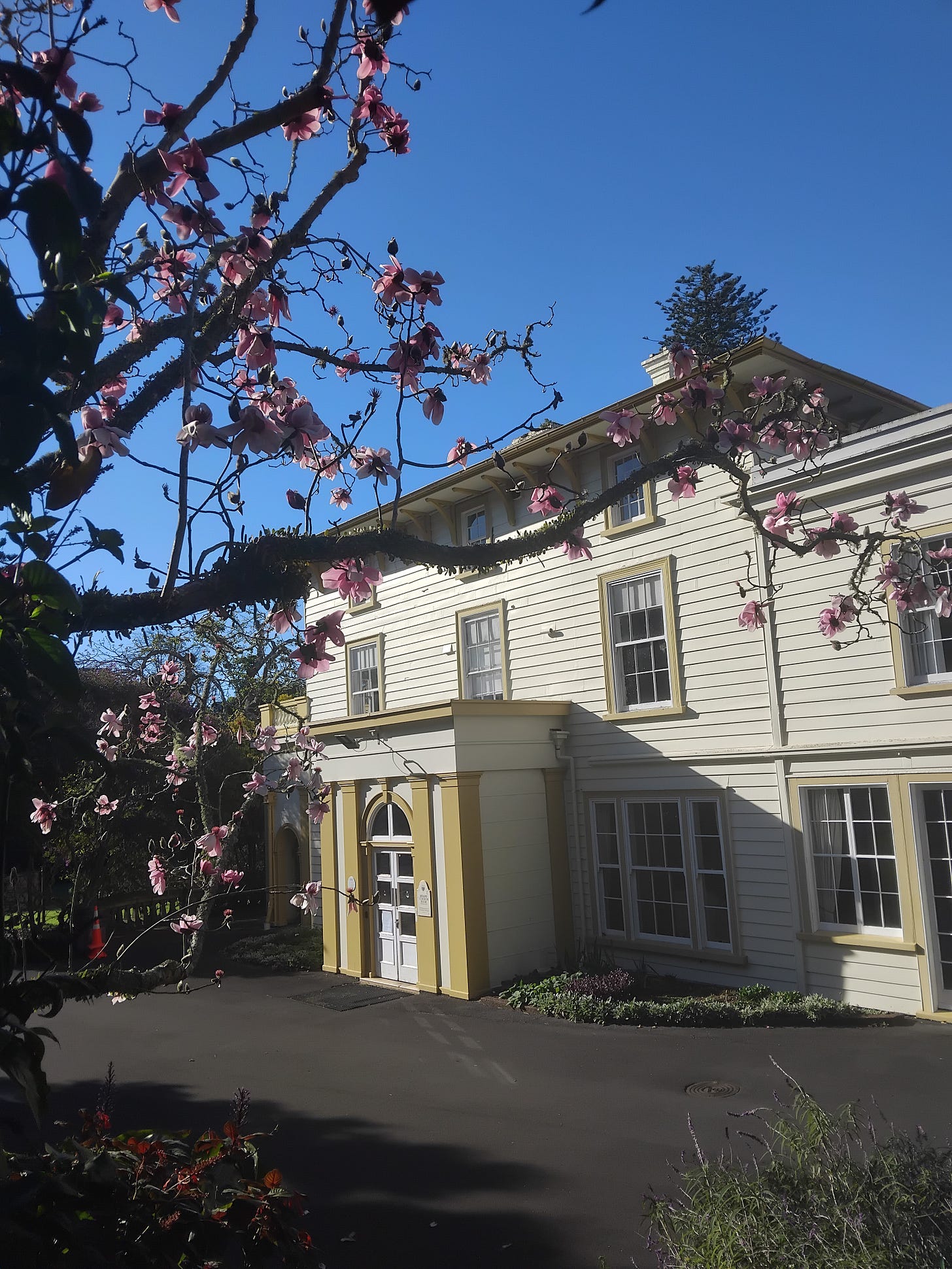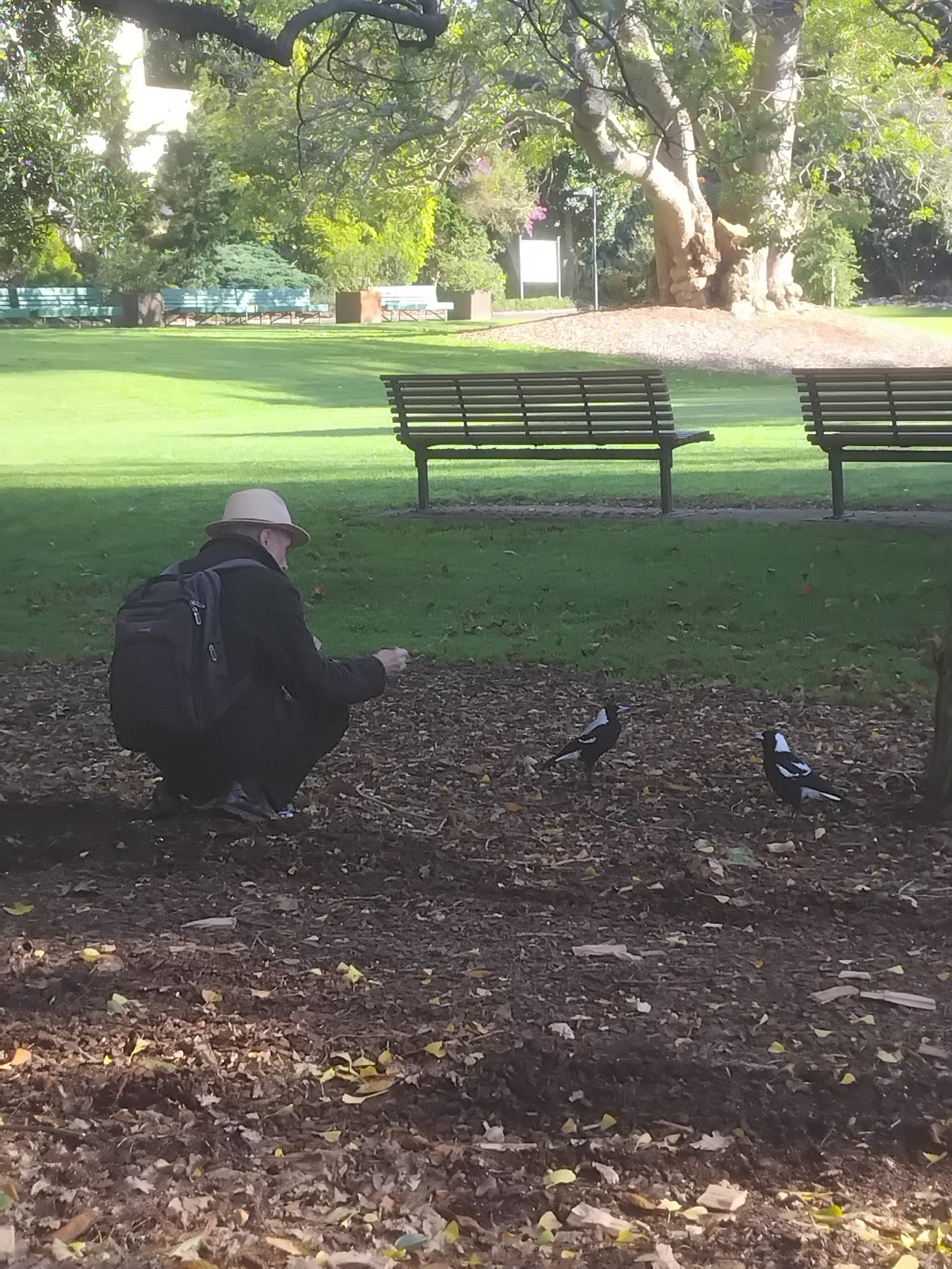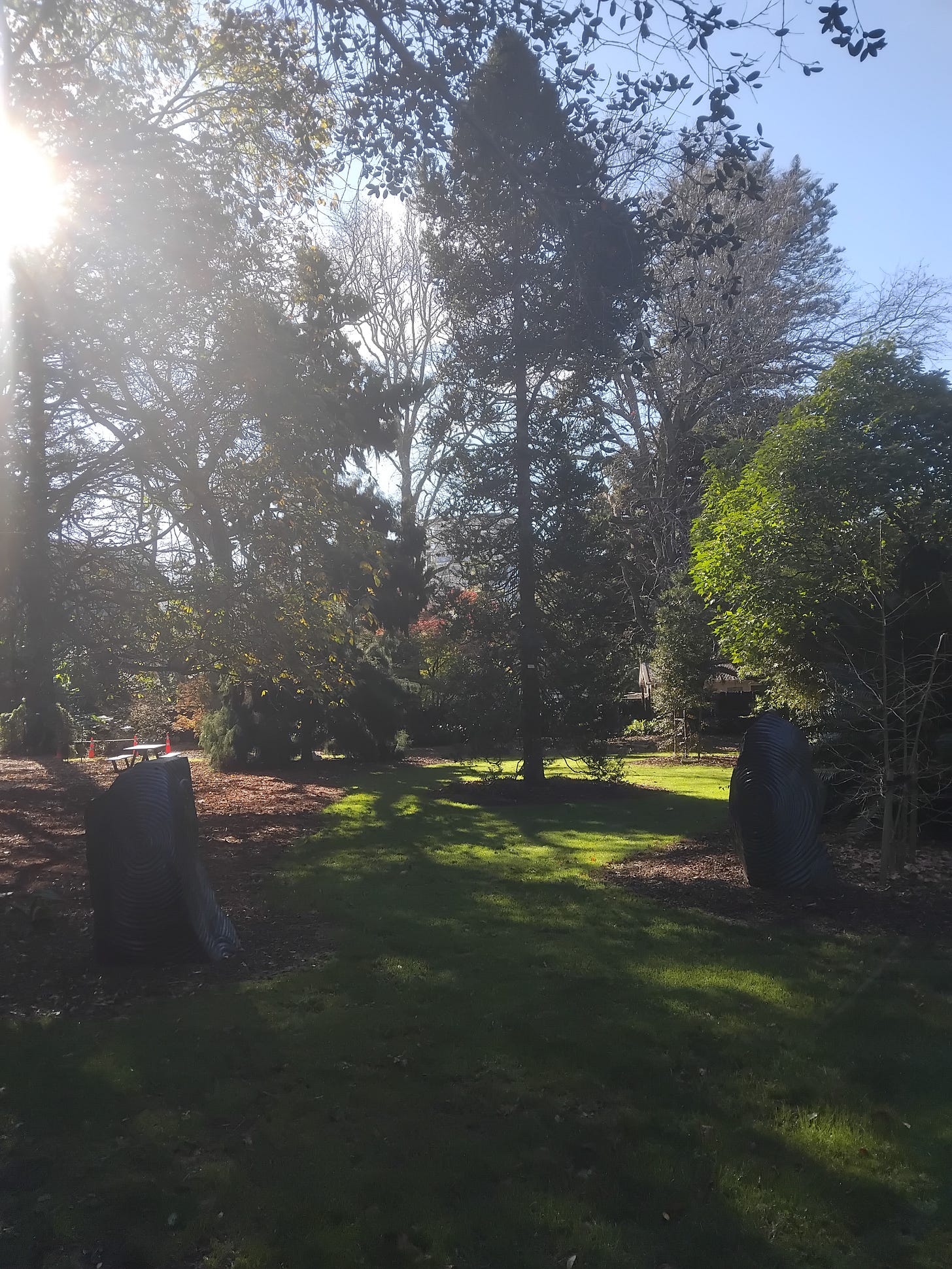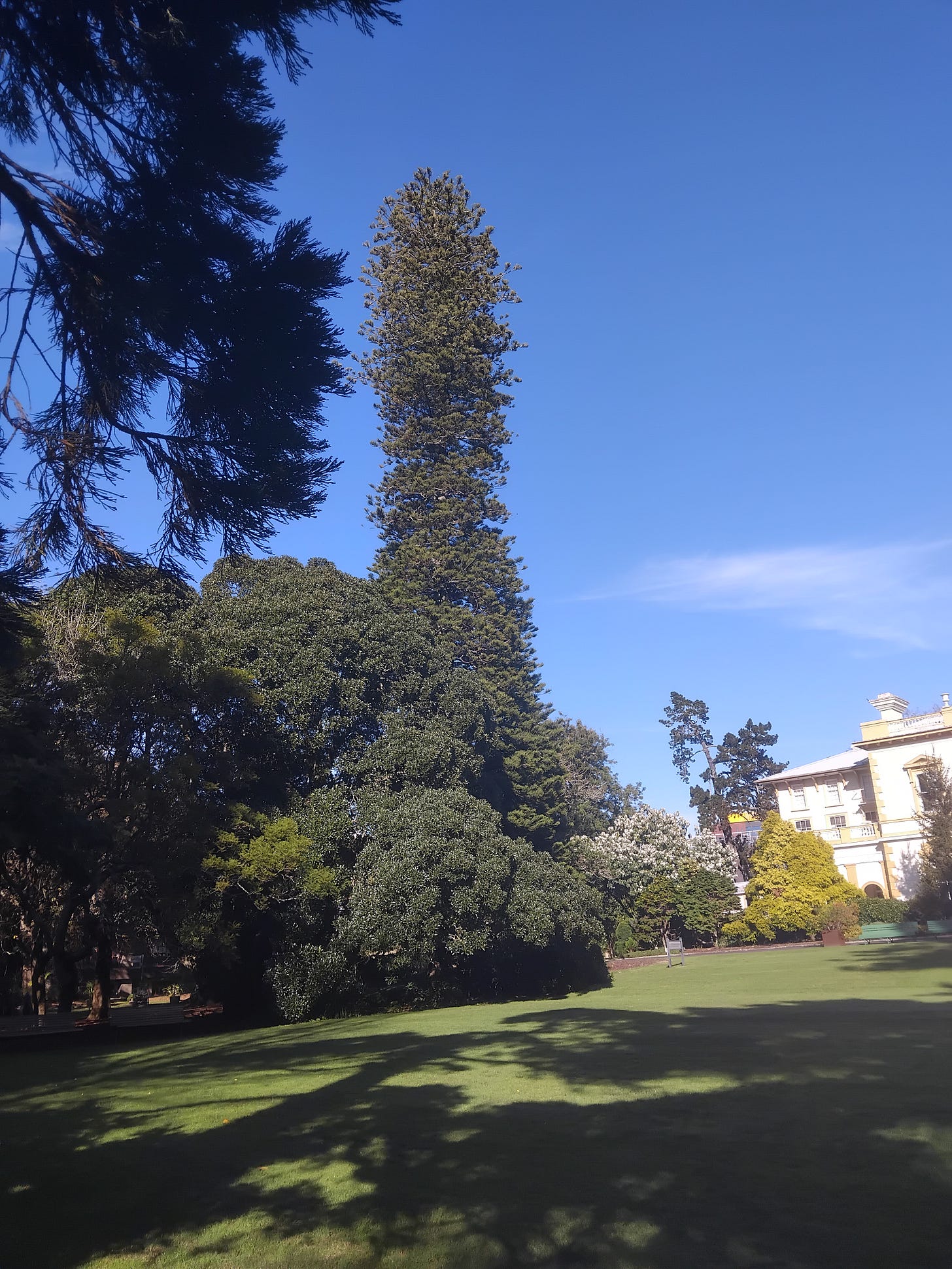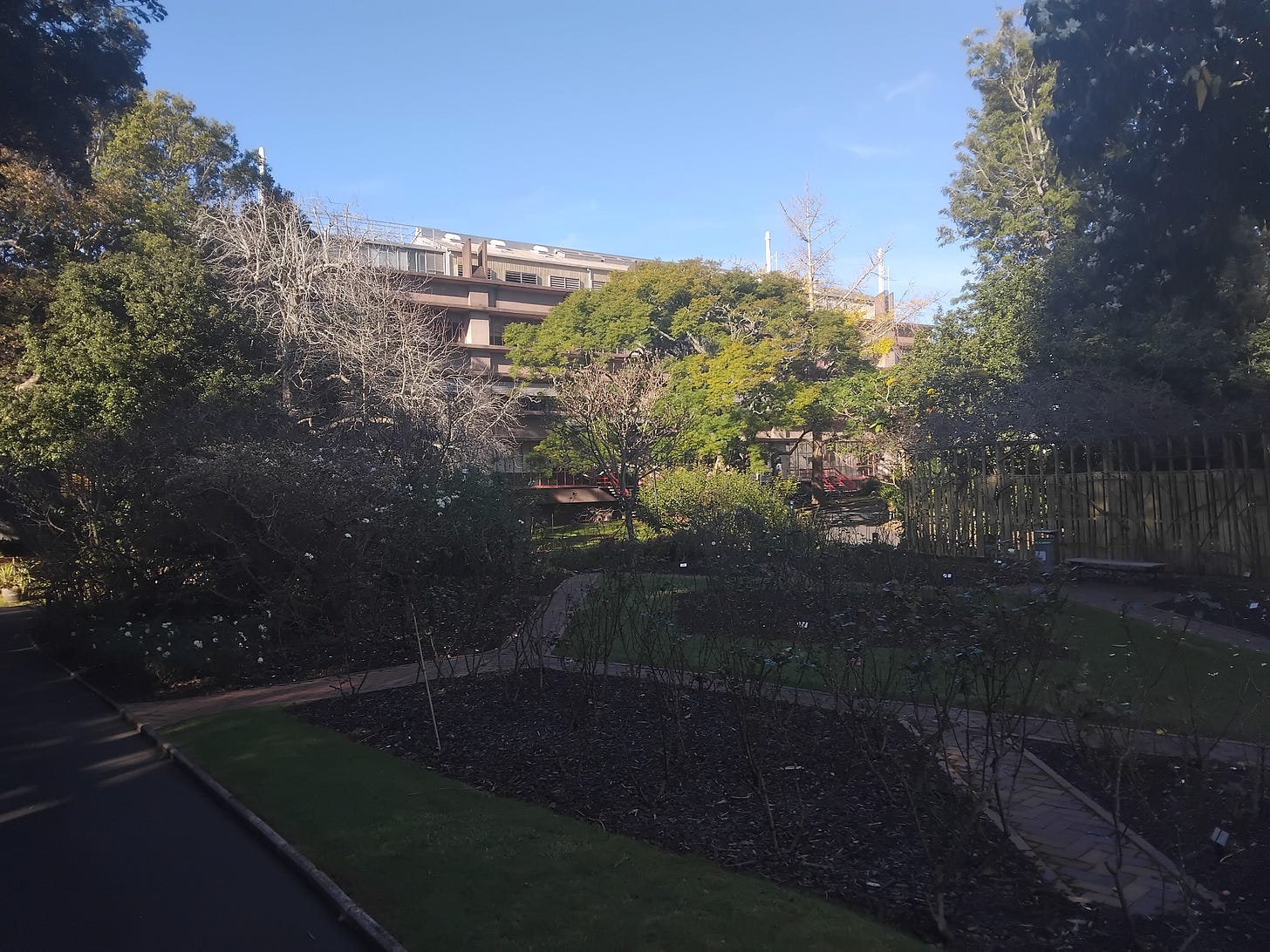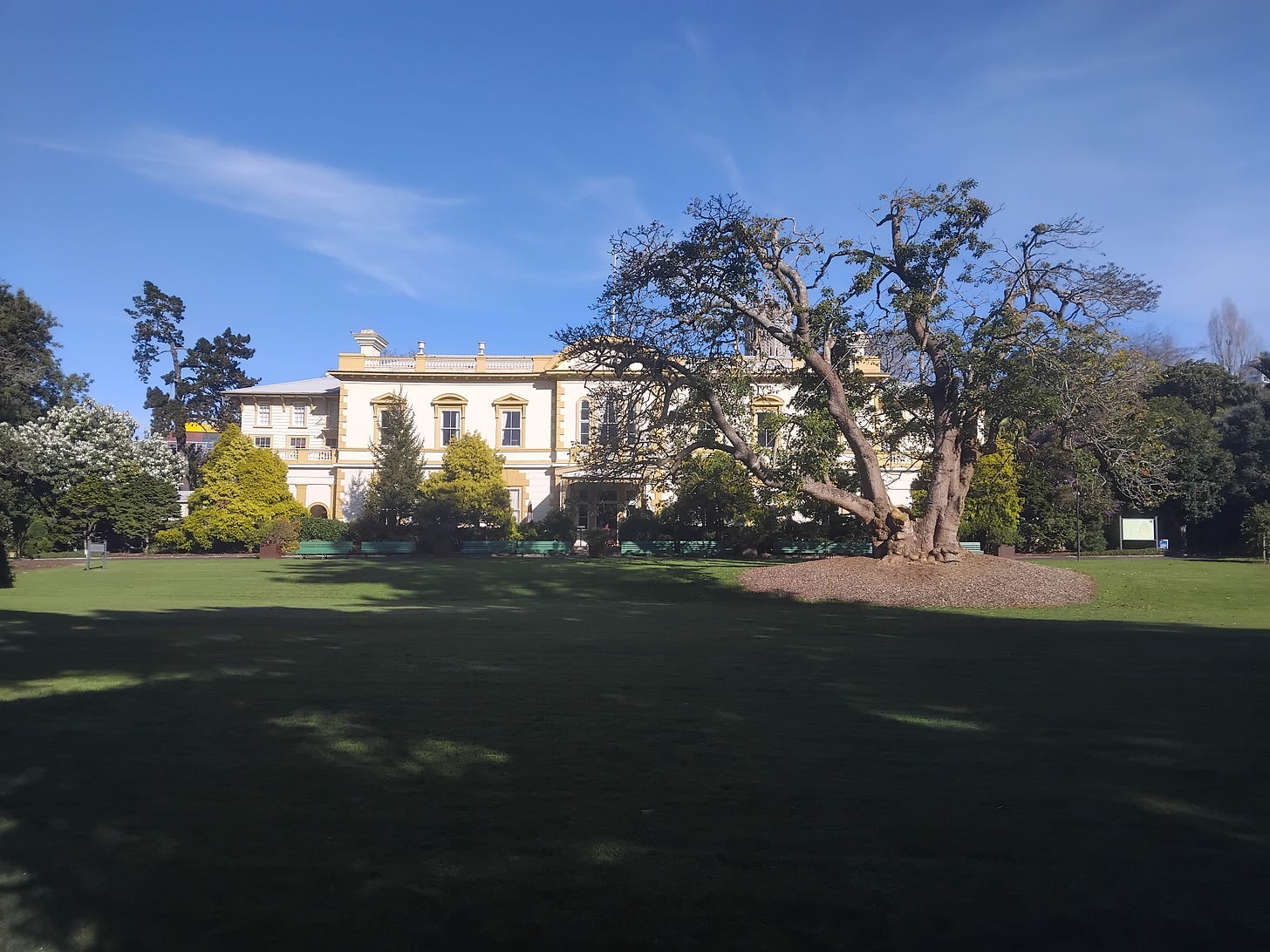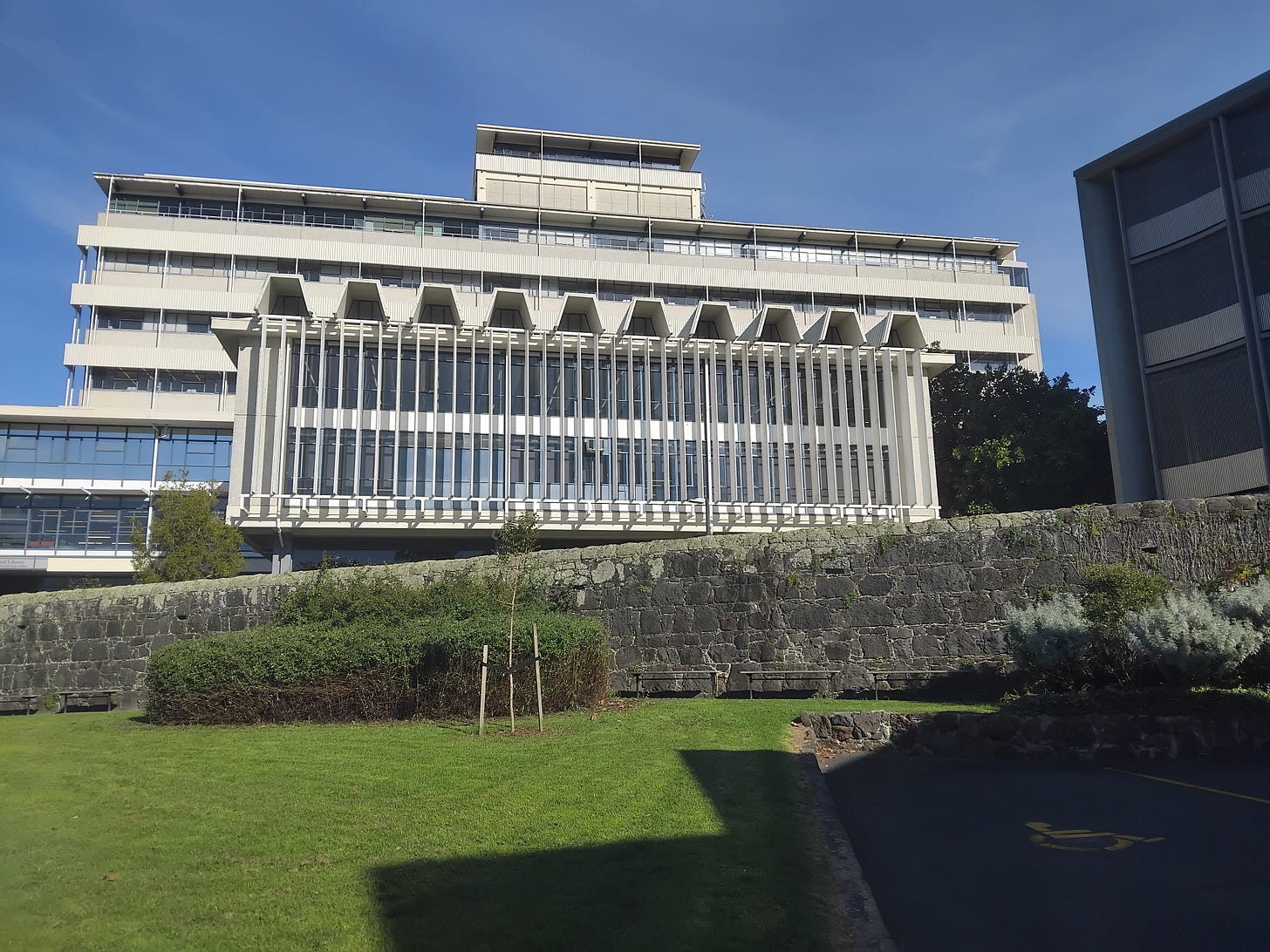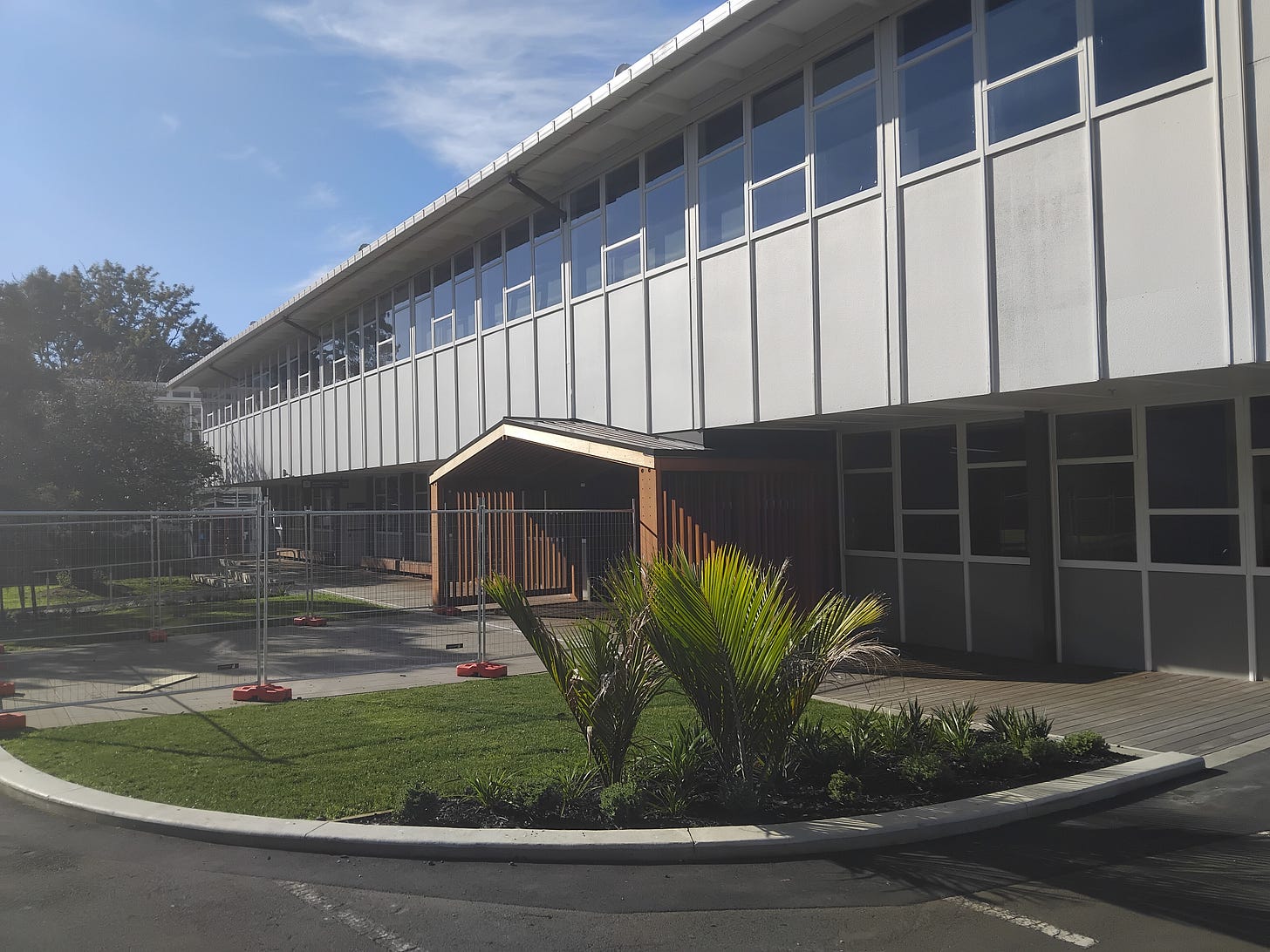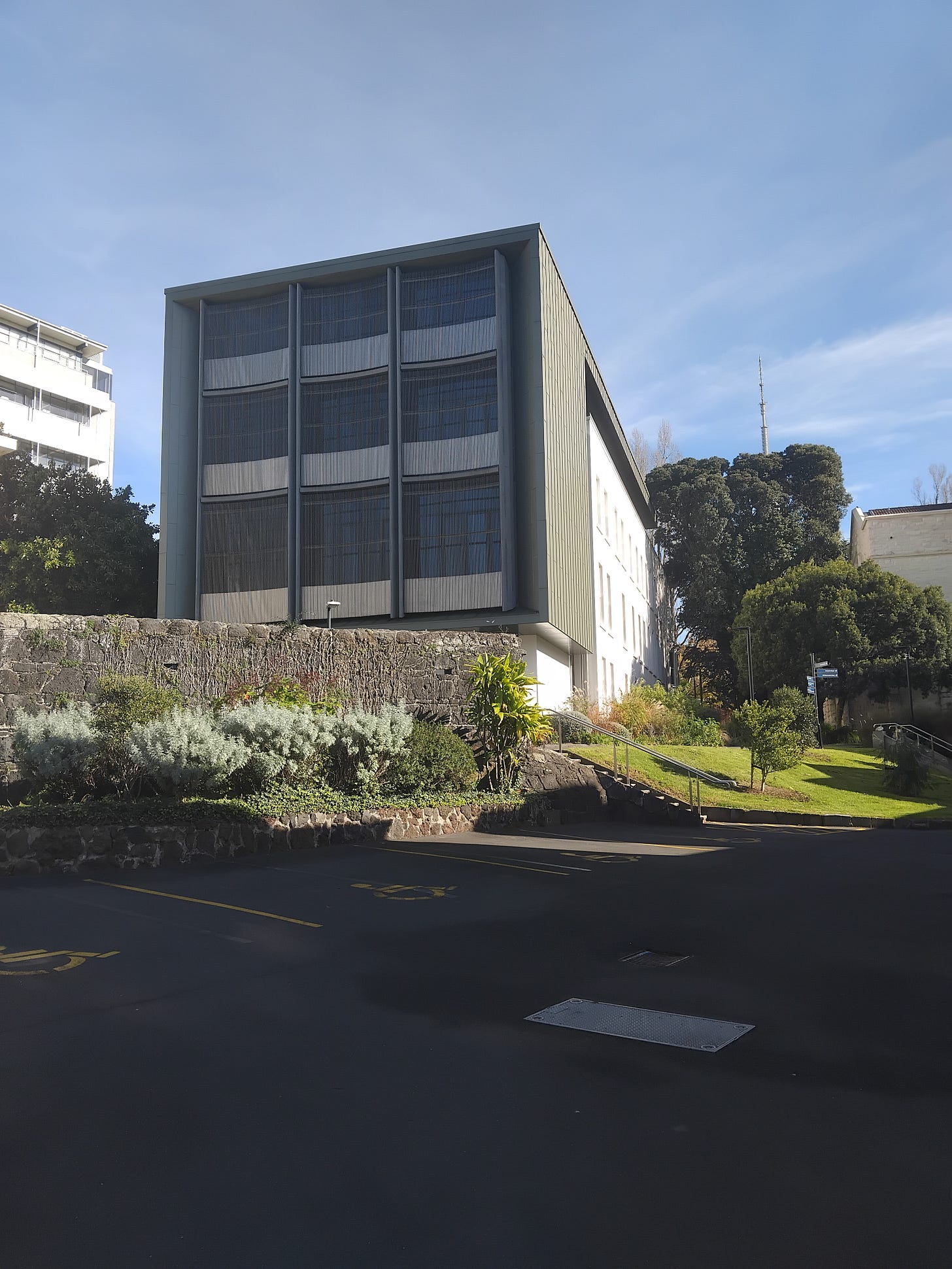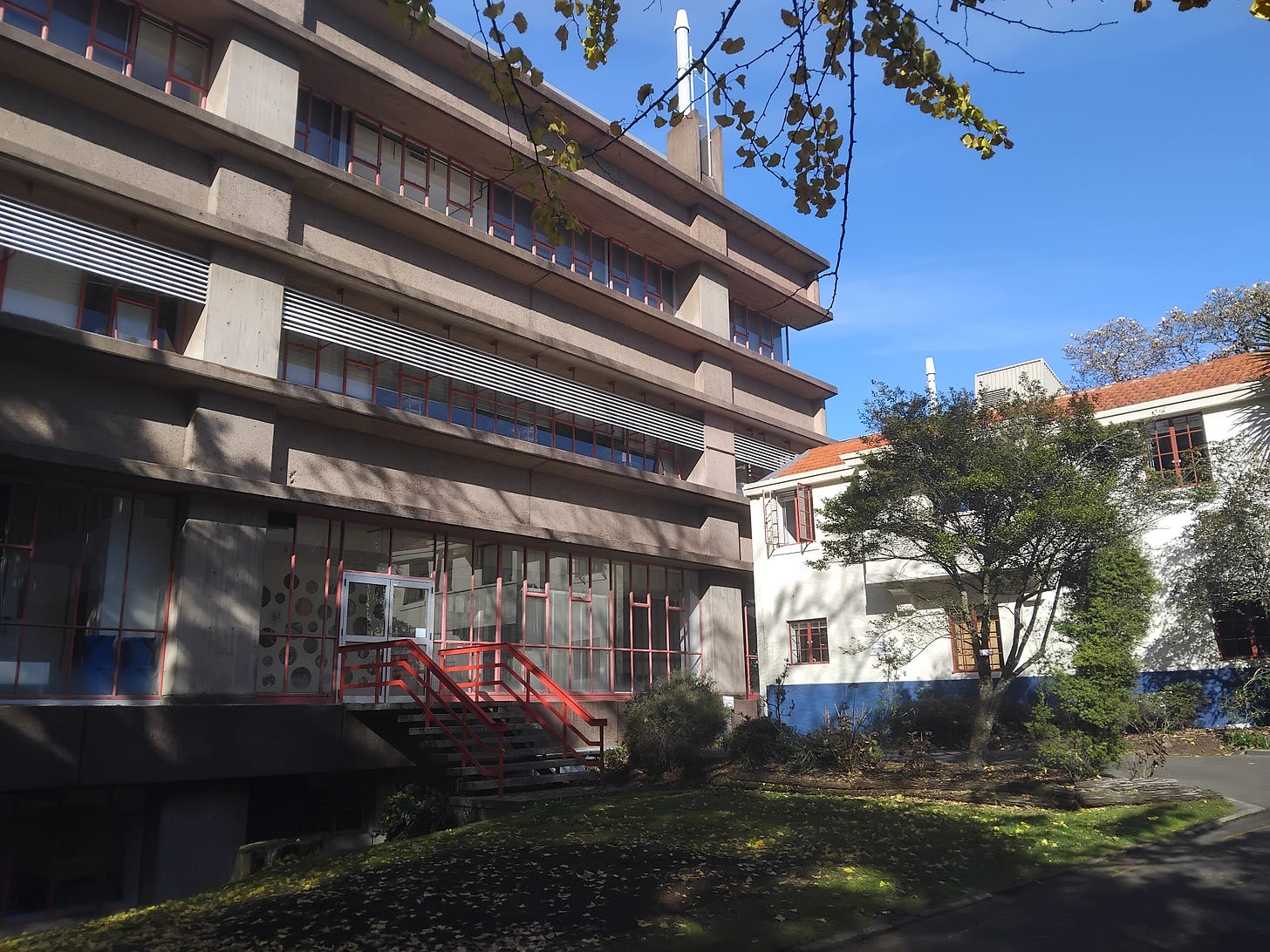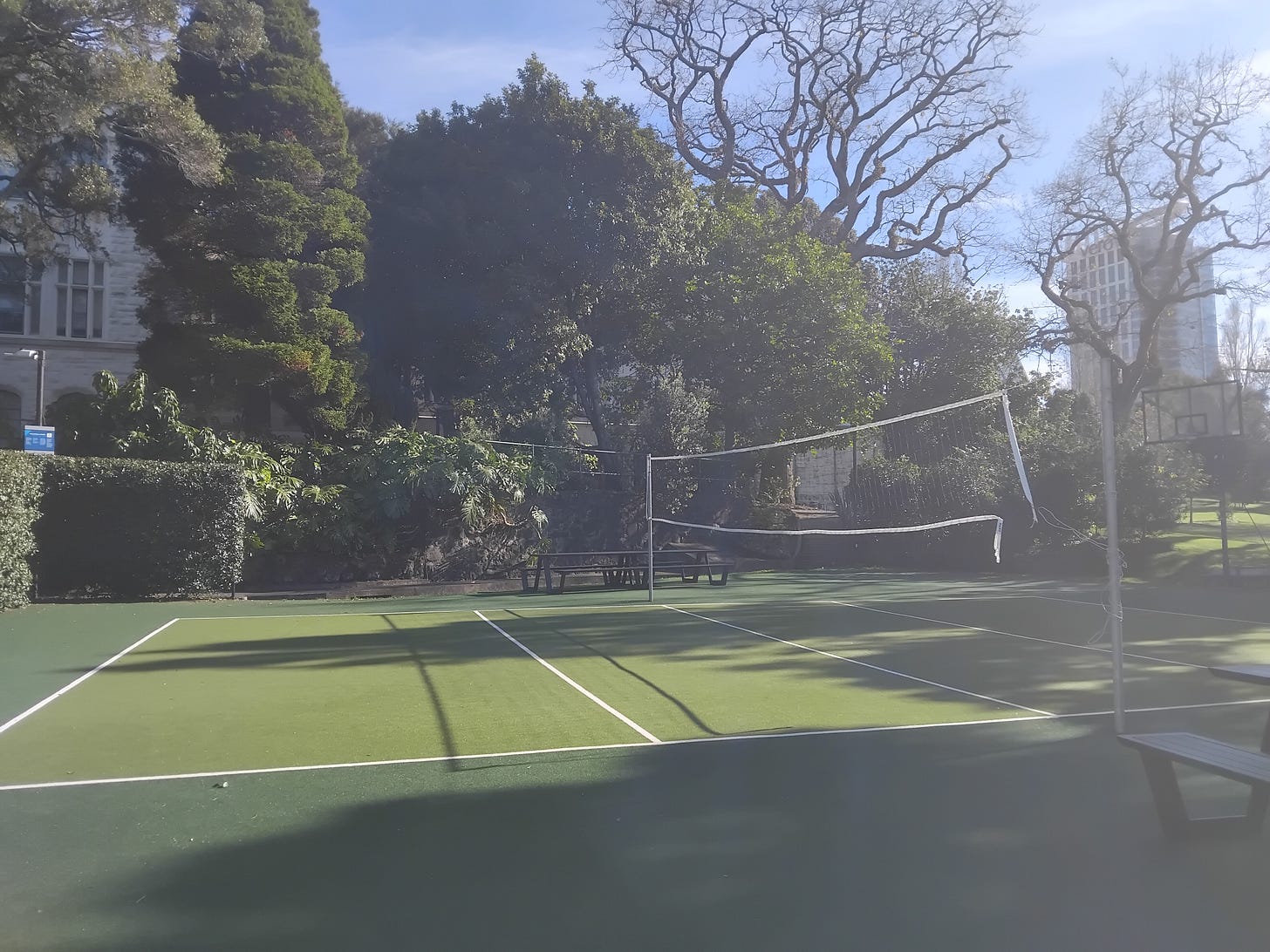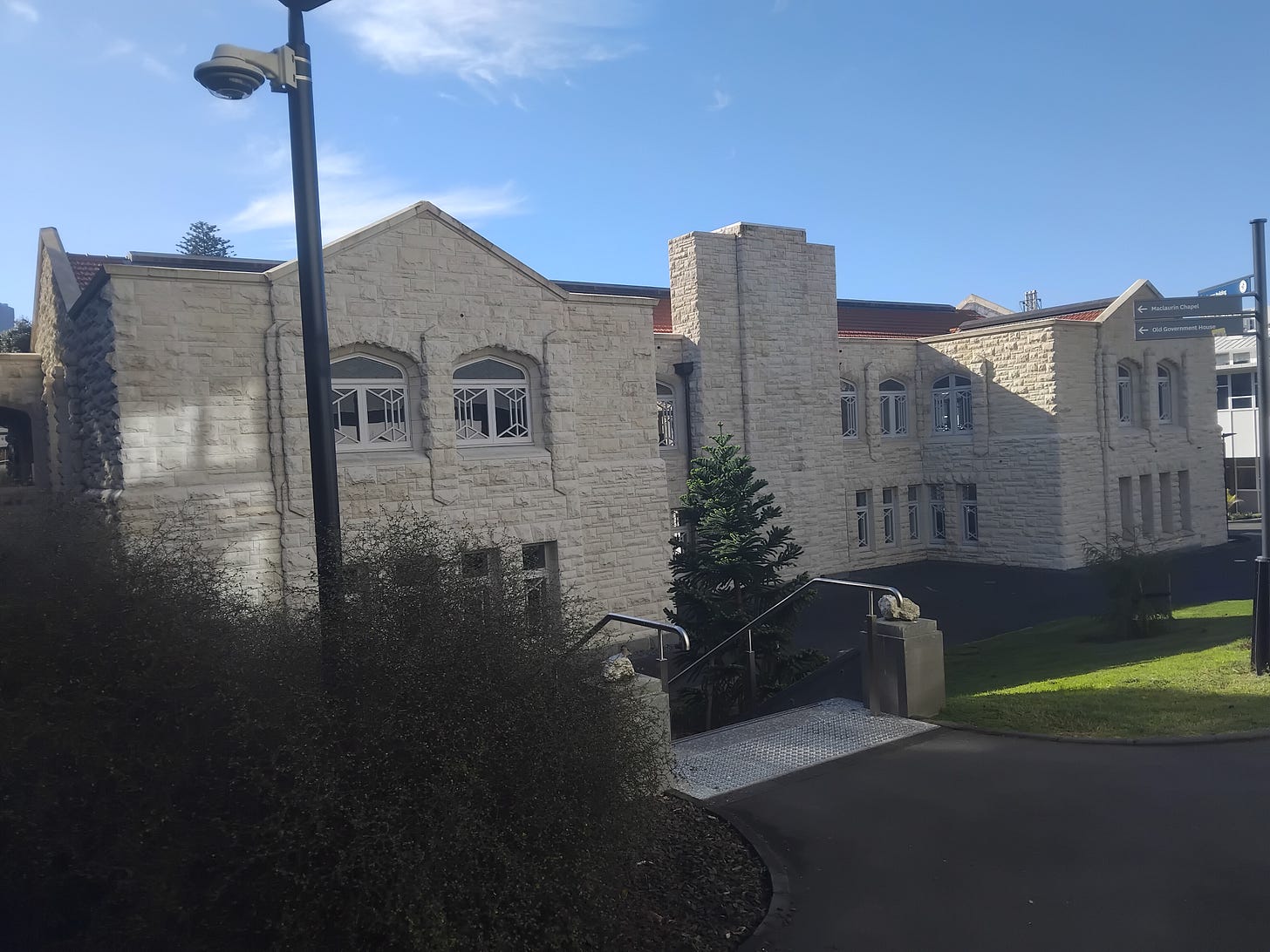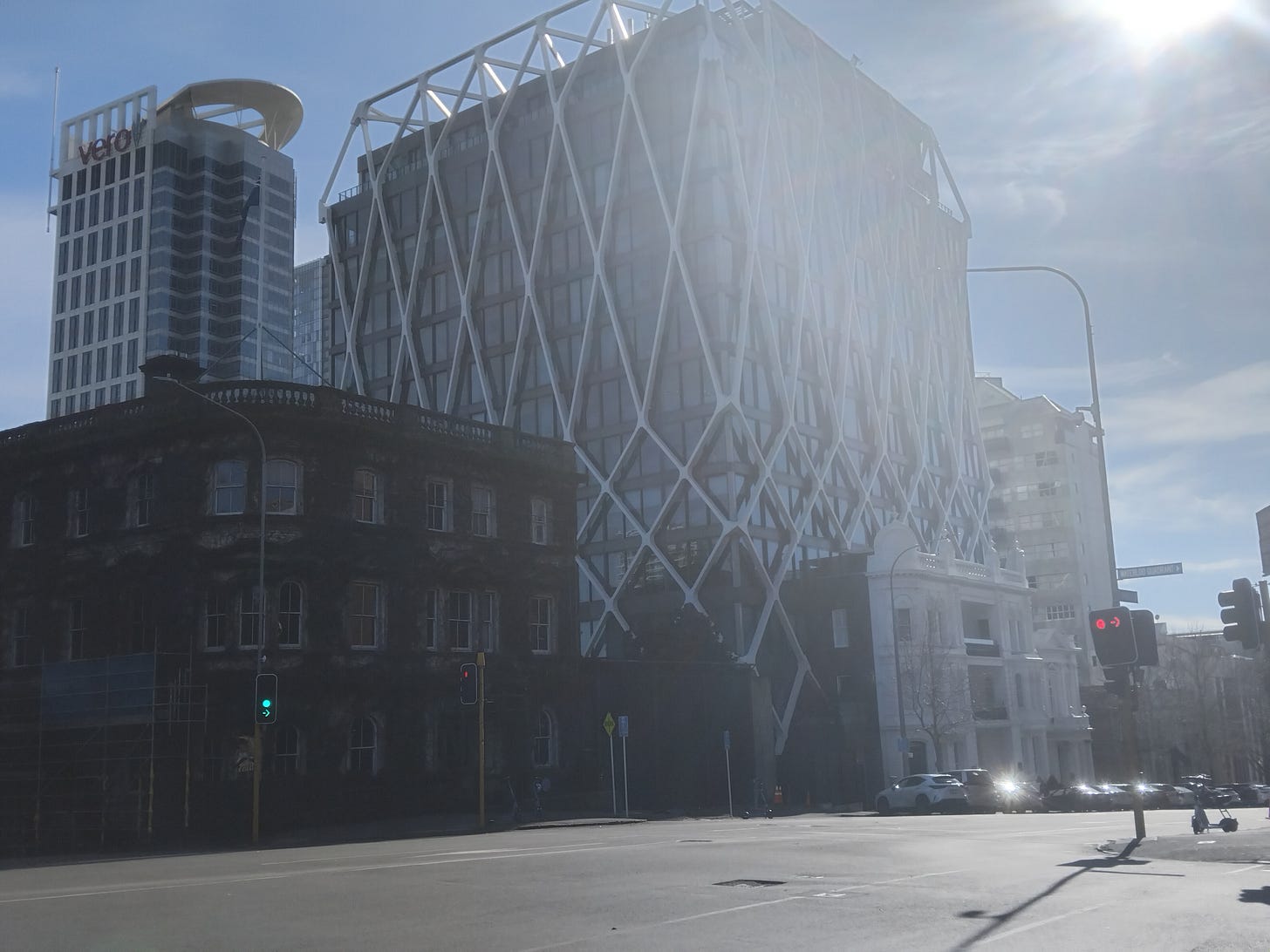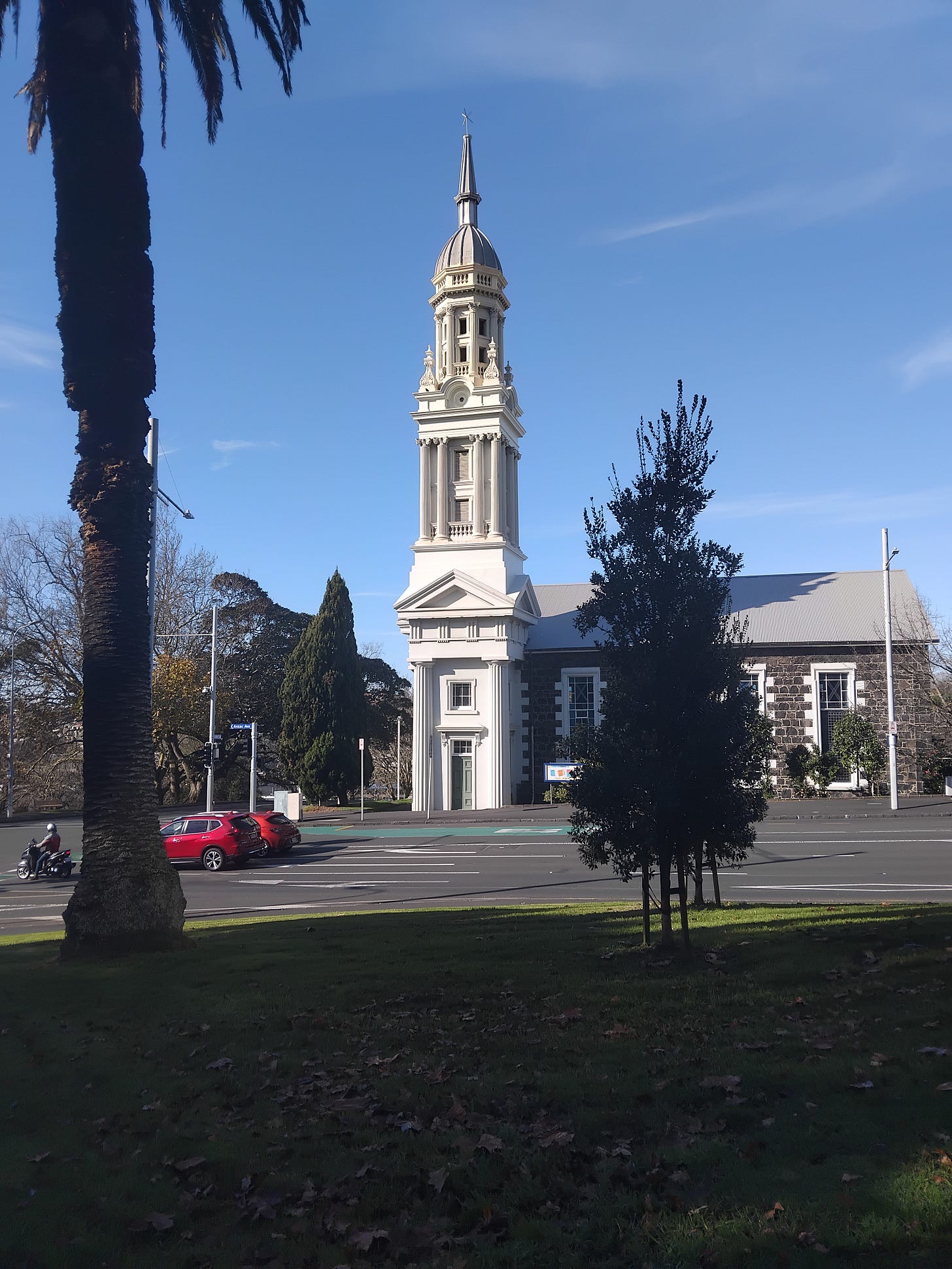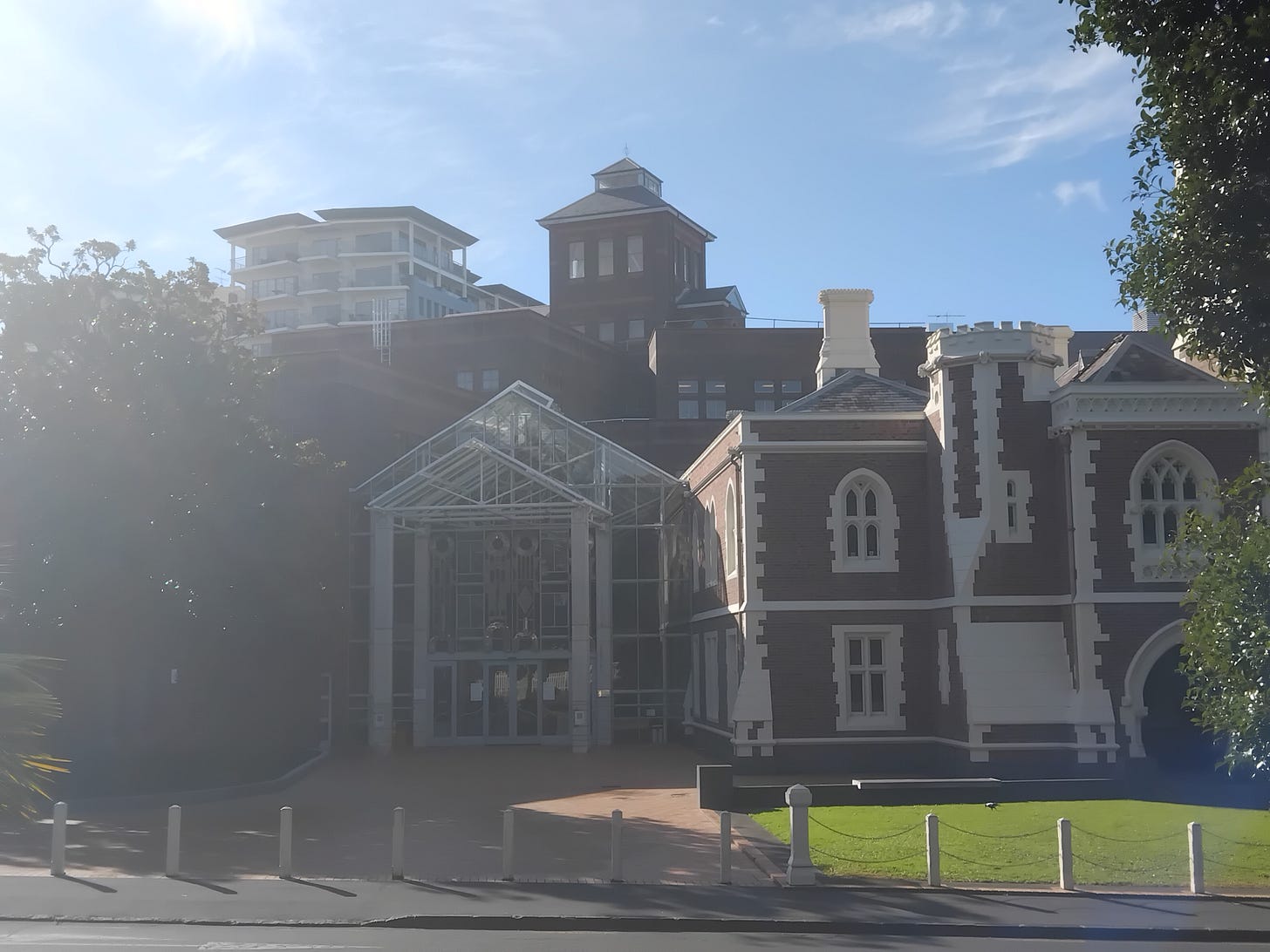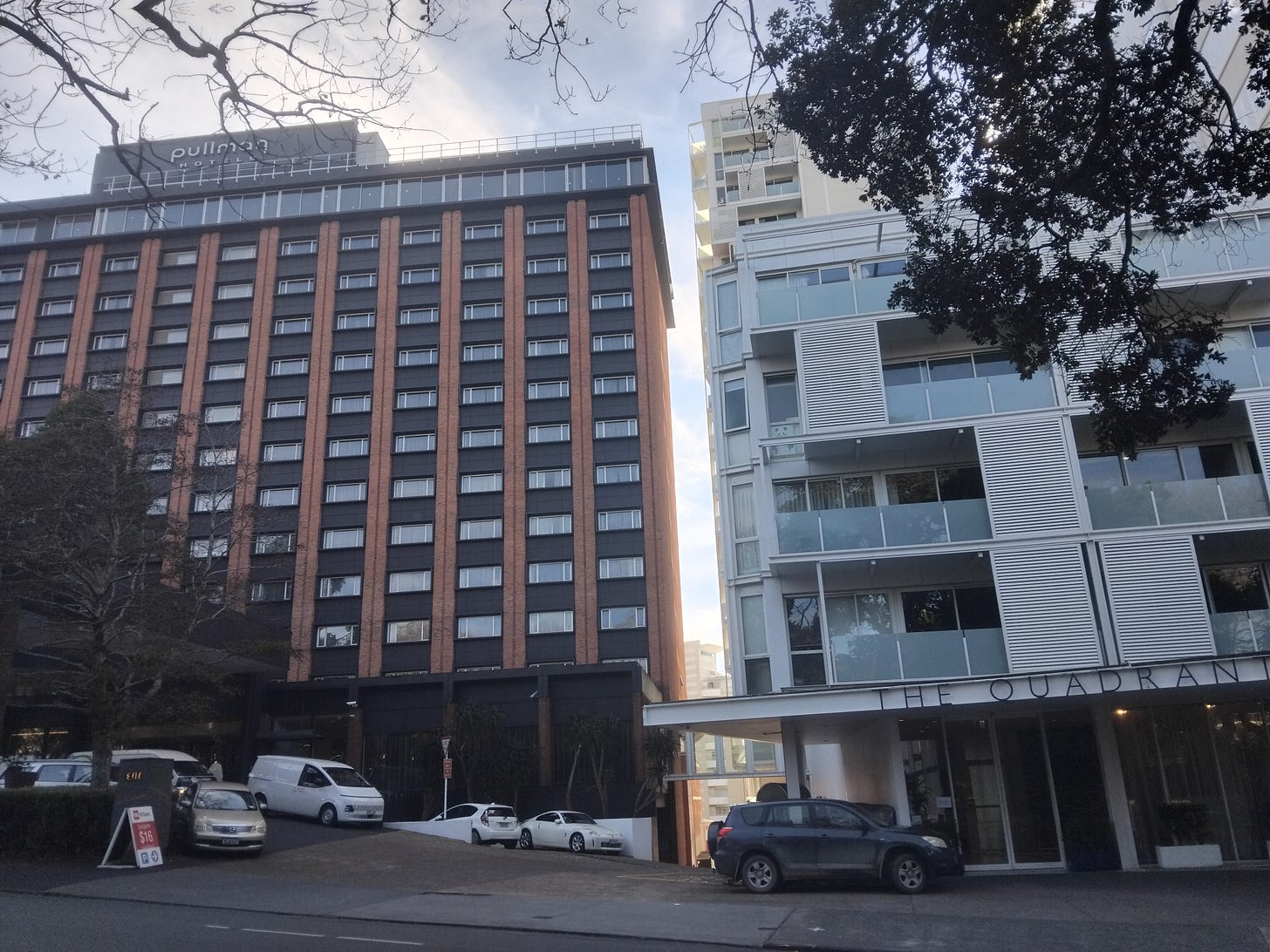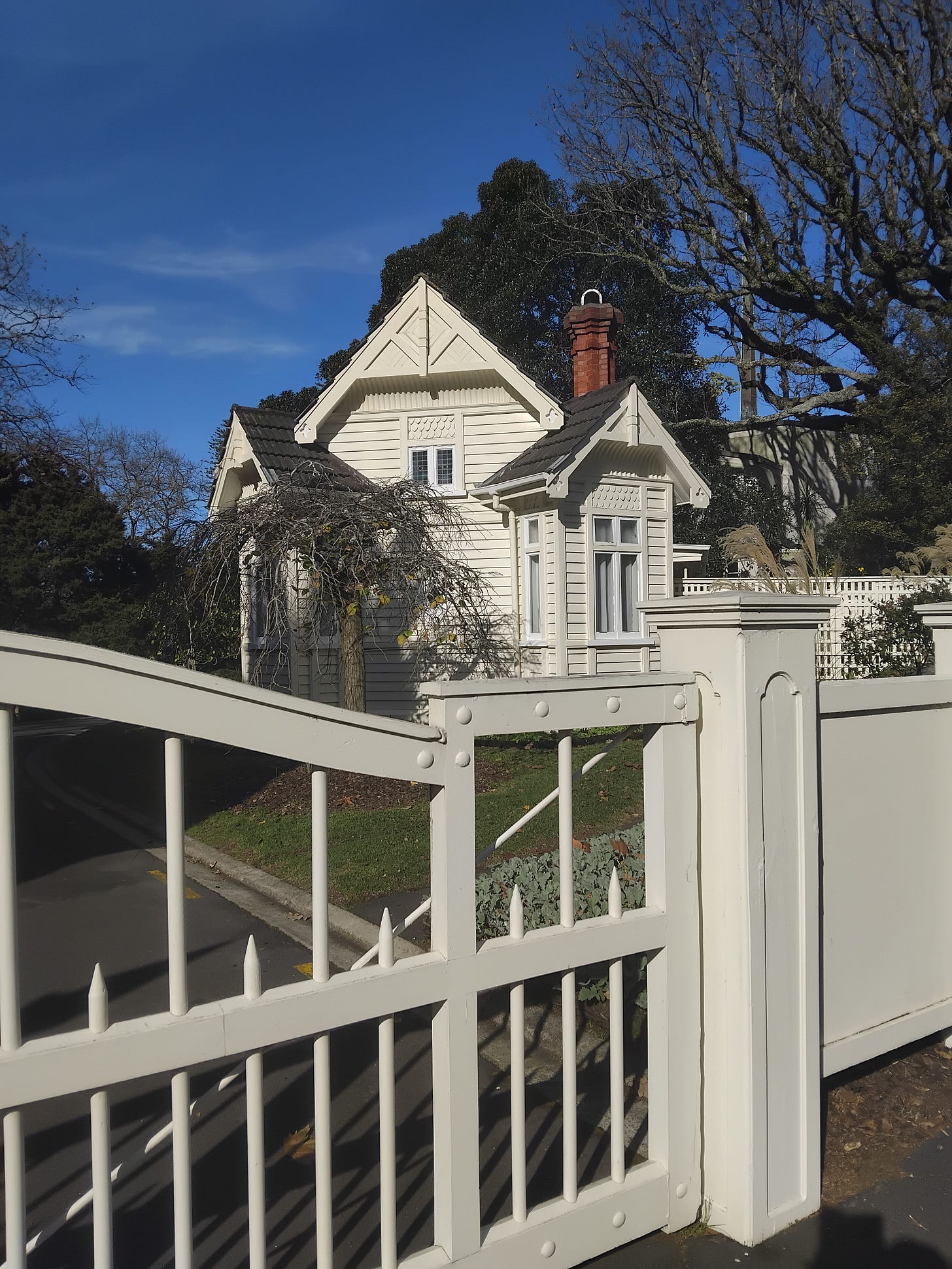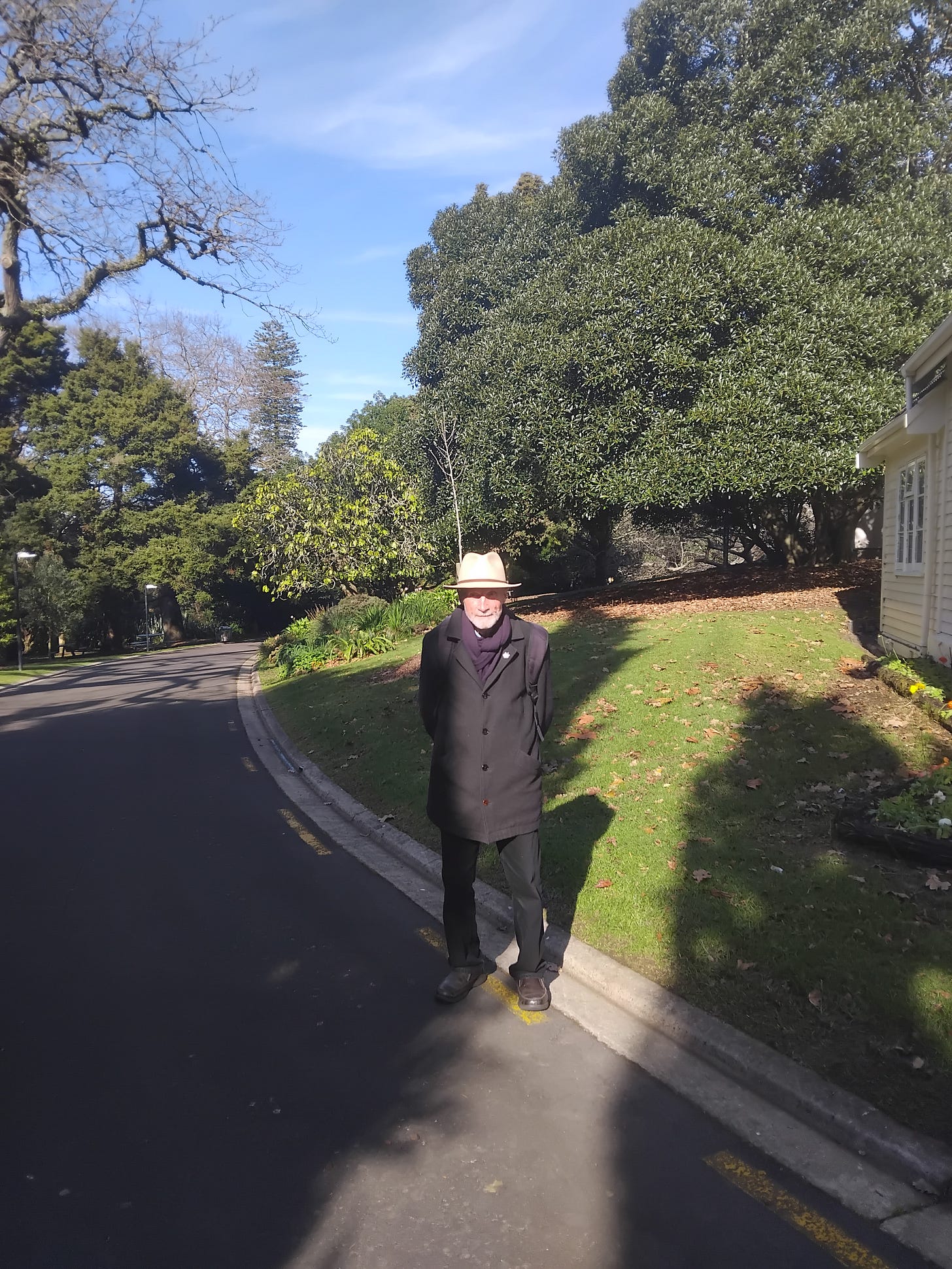“My favourite urban park is an oasis of calm and community in the middle of downtown”
This is how Jeff describes Old Government House Lawn, a park near the apartment he shares with his partner Noriko. Jeff is a retired former journalist who now rents by necessity after his horrific experiences with the leaky building crisis. Born and raised in Auckland, he has lived in cities all over the world, but Auckland’s City Centre is where he has chosen to, and I quote, “End my days here”.
I met Jeff outside The Clock Tower at the University of Auckland on the sunny, yet chilly, morning of Matariki. I wasn’t quite sure where I was going to be shown, but Jeff lead me into towards Old Government House and its Lawn.
As we walked along Princes street Jeff began to chronicle the colonial history of this area. What shifted from a fortified town in the 1850’s, to the manors of rich merchant and grand hotels. A number of prominent Jewish families lived in this part of the city - the Synagogue a testament to that - and over the years there have been a number of Jewish Mayors of Auckland, most well known I think Dove-Myer Robinson.
This was once the richest street of New Zealand, and the heart of colonial Auckland. But as Jeff spoke of the lurid details of history, which I’m sure I remember a mischievous grin on his face, there once were grand Gatsby like parties full of what were the ‘legal hard drugs’ of laudanum (opium), cocaine and so on. Protected by stone walls, which were built for the Albert Barracks in fears of invasion from the north and south, it was once the exclusive street of colonial Auckland. It acted as an enclave for the rich and powerful and, in fact, it represented the center of power in colonial New Zealand.
It’s a different world than the present, the buildings of the university with students and people from all over the world, the public space of Albert Park, and only a few of the old manors remain.
As we entered the university grounds we went from what Jeff describes as the “heart of the city, to native forest”. Next to Old Government House, gardens and wilds of trees and plants of all types. Kauri, Totara, Oaks, Pine, Japanese Fir, Himalayan Magnolia, Giant Redwood and many more.
Some of which have been planted by figures of history, such as the Redwood and Pine planted by one of the sons of Queen Victoria, Prince Alfred. Or a Rimu, planted by the late Queen Elizabeth II in 1956, when she was in New Zealand as the first reigning British Monarch to visit. Yet these giants outlive such figures, towering shade still extending over the grass and paths.
As Jeff says “You wouldn’t believe you are in the heart of Auckland”, and you really wouldn’t. Even if it’s a walk around the corner to Shortland or High Street, where you can be amongst the diversity of people that Auckland has (and one of the reasons Jeff loves the City Centre).
Like so many of our parks and walks in Auckland, sometimes you can’t see a building in sight. And as we go down to Old Government House, Jeff muses that to him, along with many others in the area, the park is “like a village green”. It’s where he goes to read the paper each morning at the café in Old Government House, to run into friends and neighbors (which happened on our visit), and to feed the regular cohort of birds.
While sparrows and pigeons are common, there is a pair of Magpies, Boris (named by Jeff after Boris Johnson because “he’s a bit of a comedian”), and Juno (after the film Juno, as “she’s a feisty one”).
The gardens and trees also show a different history, and connection all over the world. One which Jeff explains, is determined by the gardeners. One in the past was fond of Japanese trees and gardens, and so a parts of the grounds are filled with vegetation native to Japan. Other parts are filled with newly planted natives. The current gardener has also cultivated plants from Samoa and wider Polynesia.
The long shadow of colonial history permeates this place, yet as the years go by other people and voices have made their mark through the many types of flora that we can walk past. And as the climate changes, Jeff has observed that many of the trees themselves change, losing leaves or keeping them at odd times of the year, perhaps reflecting how time is changing for us as well.
Yet, as large a perspective as you want to take of this place, to someone like Jeff living nearby in his apartment, this is his backyard.
And it helps that Old Government House has, according to Jeff, one of the best bars and cafes in Auckland. Although, it is always amusing to remember this used to be the seat of government in New Zealand. And the historical connections don’t stop there. Jeff talked about a grey cat called Governor Grey who used to, until his retirement, reside on the premise.
It’s a place seeped in history and Jeff had a keen mind for it all. Yet while there are many literal tree roots going back into the past here, during, and as our walk continued, Jeff also spoke of the architectural history of the area. Because as much as the gardens echo history, the buildings and those that stand tell it’s story as well.
For Jeff, Auckland has had a serious problem with retaining its architectural heritage. Once where the streets were lines with beautiful elaborate manors of the Victorian colonial rich, now only a few remain. Remembering what used to be around angered Jeff, frustrating him with what we had lost as a city.
There is now an eclectic mix of different buildings where once the street was lined with Victorian Manors. Jeff says there has been “no concept of symmetry” used with the design of new buildings, with developers having set up with no thought of ensuring designs would match the areas history.
You can see what has been built when. As how the different parts of the garden differ from their time, you can see those old Victorian manors, you can see the rise of art deco in the 1920/30’s, the brutalist fortresses, and modern mess of steel and glass.
Jeff talked about how nearby Queen Street once had theatres that ‘rivaled Broadway’, now almost all demolished. We talked of the different buildings that remained however tenuous, like the St James, and those that were demolished regardless of peoples opposition, like His Majesty’s Theatre. The pioneering society of old, or the “Boring society” of rugby, racing, and beer, as Jeff calls it, had meant we had a “crudeness to us we haven’t got rid off”. And for him this has meant we have had undertones of opposition to arts, intellectualism and the elite, often resulting in blatant “cultural vandalism”.
The University drew a lot of Jeff’s ire, to him those that are supposed to represent the intellectual side of society, and have been a “pretty poor guardian of architectural history”. The need to be “functional”, rife as both the excuse for change and the philosophy of design, had resulted in many disparate choices of what to build and how. He pointed out to me how little thought there was to additions to old buildings, out of place to what the original structure was, the volleyball court oddly placed next to Old Government House, and a brutalist structure which “even Stalin would wince at that”.
Interspaced were buildings of history, those who still had their core identity. Even the old Albert Barracks wall still ran through the University.
Outside the University, the same was true. Many new buildings including those like the leaky apartment building Jeff had bought that were “1980’s vomit that are falling apart”. Not to mention all those leaky homes after deregulation in the building sector. Those buildings that destroy not just the identity of a place, but the lives and stability of those who looked for a home in the heart of our largest city, including Jeff’s.
Other buildings made attempts at maintaining architectural continuity. They kept their historic facades at street level, while mountains of glass and steel rose behind them. But when you look from afar, and not from up close, it looks almost comical in a way.
Yet again, some old buildings remained, the Northern Club, Churches, The High Court, and the Synagogue.
Other newer additions, did do much better in Jeff’s view. The buildings of brick behind the High Court, The Pullman Hotel (which sets next to The Quadrant, which Jeff said does not fit in). To Jeff they fit in with the architecture of old. Maintain identity with brick instead of steel and concrete. Building up in a way that matches what was before and making space for more people to live and visit the space.
And in recent years, there have been attempts at thought in the plans of Auckland’s City Centre. Jeff told me he thought, Viaduct Basin was done “quite well” and is a “reasonably good go”. And he says the City Centre Masterplan is the first attempt at seriously planning out this urban heart.
And so for Jeff we are in a city space that has had both little regard to art and design, yet still has the roots of history of structure and plant reaching up. He feels that while we may have never planned anything properly in the past, that might is changing. And while Jeff fears we may make the mistakes of the past and have more leaky buildings rise in the sky, to uproot and destroy lives as he has experienced, we also have these places of calm and community. For someone who has travelled all over the world, this area represent the best and worst of Auckland. And the best of worse of us as people.
So it’s somewhat fitting we were here on Matariki. A common theme in our conversations on our walk was reflection. Thinking about what came before us and what was left behind in the trees and gardens and buildings. What was also lost, history destroyed and demolished, to be replaced with something different.
And it might be that it was worse, that what was new did not fit in with what was. Sometimes the new was built with purpose, to fit in and continue identity and tradition and history. And those observations, and our experiences in our places, good and bad, wins and losses, they affect how we think about the future, what we fear might happen if we repeat the mistakes of the past and act with carelessness and disdain. Or what we hope might be a new approach of thoughtfulness and planning. And those will all make a mark, much like the trees planted by royalty, the gardens cultivated by many different hands, and buildings constructed up into the sky.
Except.
Regardless of the remembrance of what has been, or observations in the presence, or thoughts on the future. Jeff can still go to his oasis of a park. Not too far from the hustle and bustle and energy that the diverse crowds of people in Auckland bring, but secluded enough to be a place of solace. His, and so many others, backyard to urban living.
And maybe we can have more of those slices of peace. More places with identity and soul. We just have to take some care, and have some thought, of how we grow our gardens. And how we build our cities.




